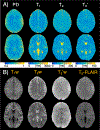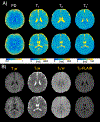A multi-inversion multi-echo spin and gradient echo echo planar imaging sequence with low image distortion for rapid quantitative parameter mapping and synthetic image contrasts
- PMID: 33764563
- PMCID: PMC8793364
- DOI: 10.1002/mrm.28761
A multi-inversion multi-echo spin and gradient echo echo planar imaging sequence with low image distortion for rapid quantitative parameter mapping and synthetic image contrasts
Abstract
Purpose: Brain imaging exams typically take 10-20 min and involve multiple sequential acquisitions. A low-distortion whole-brain echo planar imaging (EPI)-based approach was developed to efficiently encode multiple contrasts in one acquisition, allowing for calculation of quantitative parameter maps and synthetic contrast-weighted images.
Methods: Inversion prepared spin- and gradient-echo EPI was developed with slice-order shuffling across measurements for efficient acquisition with T1 , T2 , and weighting. A dictionary-matching approach was used to fit the images to quantitative parameter maps, which in turn were used to create synthetic weighted images with typical clinical contrasts. Dynamic slice-optimized multi-coil shimming with a B0 shim array was used to reduce B0 inhomogeneity and, therefore, image distortion by >50%. Multi-shot EPI was also implemented to minimize distortion and blurring while enabling high in-plane resolution. A low-rank reconstruction approach was used to mitigate errors from shot-to-shot phase variation.
Results: The slice-optimized shimming approach was combined with in-plane parallel-imaging acceleration of 4× to enable single-shot EPI with more than eight-fold distortion reduction. The proposed sequence efficiently obtained 40 contrasts across the whole-brain in just over 1 min at 1.2 × 1.2 × 3 mm resolution. The multi-shot variant of the sequence achieved higher in-plane resolution of 1 × 1 × 4 mm with good image quality in 4 min. Derived quantitative maps showed comparable values to conventional mapping methods.
Conclusion: The approach allows fast whole-brain imaging with quantitative parameter maps and synthetic weighted contrasts. The slice-optimized multi-coil shimming and multi-shot reconstruction approaches result in minimal EPI distortion, giving the sequence the potential to be used in rapid screening applications.
Keywords: low distortion EPI; multi-shot acquisitions; quantitative mapping; synthetic imaging.
© 2021 International Society for Magnetic Resonance in Medicine.
Figures










Similar articles
-
Echo planar time-resolved imaging (EPTI).Magn Reson Med. 2019 Jun;81(6):3599-3615. doi: 10.1002/mrm.27673. Epub 2019 Feb 3. Magn Reson Med. 2019. PMID: 30714198 Free PMC article.
-
Simultaneous T1, T2 and T2⁎ mapping of the liver with multi-shot MI-SAGE.Magn Reson Imaging. 2024 Jan;105:75-81. doi: 10.1016/j.mri.2023.11.004. Epub 2023 Nov 7. Magn Reson Imaging. 2024. PMID: 37939972
-
3D-EPI blip-up/down acquisition (BUDA) with CAIPI and joint Hankel structured low-rank reconstruction for rapid distortion-free high-resolution mapping.Magn Reson Med. 2023 May;89(5):1961-1974. doi: 10.1002/mrm.29578. Epub 2023 Jan 27. Magn Reson Med. 2023. PMID: 36705076 Free PMC article.
-
In vivo B0 field shimming methods for MRI at 7T.Neuroimage. 2018 Mar;168:71-87. doi: 10.1016/j.neuroimage.2017.06.013. Epub 2017 Jun 7. Neuroimage. 2018. PMID: 28602943 Free PMC article. Review.
-
Principles and Progress in ultrafast 2D spatiotemporally encoded MRI.Prog Nucl Magn Reson Spectrosc. 2025 Apr-Jun;146-147:101559. doi: 10.1016/j.pnmrs.2025.101559. Epub 2025 Feb 13. Prog Nucl Magn Reson Spectrosc. 2025. PMID: 40306799 Review.
Cited by
-
Optimization and validation of multi-echo, multi-contrast SAGE acquisition in fMRI.Imaging Neurosci (Camb). 2024 Jul 2;2:1-20. doi: 10.1162/imag_a_00217. eCollection 2024 Jul 1. Imaging Neurosci (Camb). 2024. PMID: 39449748 Free PMC article.
-
Mapping astrogliosis in the individual human brain using multidimensional MRI.Brain. 2023 Mar 1;146(3):1212-1226. doi: 10.1093/brain/awac298. Brain. 2023. PMID: 35953450 Free PMC article.
-
A single 1-min brain MRI scan for generating multiple synthetic image contrasts in awake children from quantitative relaxometry maps.Pediatr Radiol. 2025 Feb;55(2):312-323. doi: 10.1007/s00247-024-06113-1. Epub 2024 Dec 18. Pediatr Radiol. 2025. PMID: 39692886
-
Primary Multiparametric Quantitative Brain MRI: State-of-the-Art Relaxometric and Proton Density Mapping Techniques.Radiology. 2022 Oct;305(1):5-18. doi: 10.1148/radiol.211519. Epub 2022 Aug 30. Radiology. 2022. PMID: 36040334 Free PMC article. Review.
-
Multidimensional MRI for Characterization of Subtle Axonal Injury Accelerated Using an Adaptive Nonlocal Multispectral Filter.Front Phys. 2021;9:737374. doi: 10.3389/fphy.2021.737374. Epub 2021 Sep 16. Front Phys. 2021. PMID: 37408700 Free PMC article.
References
Publication types
MeSH terms
Grants and funding
LinkOut - more resources
Full Text Sources
Other Literature Sources

